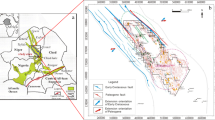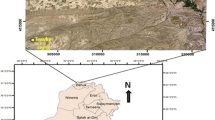Abstract
The Jiyang Sag and the Liaohe Basin are the two important areas where immature oil resources are distributed in China. From these two areas immature-low mature to mature oil samples were collected for carbon isotopic analysis. The extracts of source rocks are dominant in the Jiyang Sag while crude oils are dominant in the Liaohe Basin. The maturity index, Ro, for source rocks varies from 0.25% (immature) to 0.65% (mature). Studies have shown that within this range of Ro values the extracts of source rocks and crude oils, as well as their fraction components, have experienced observable carbon isotope fractionation. The carbon isotopic values tend to increase with burial depth, the oils become from immature-low mature to mature, and the rules of evolution of oils show a three-stage evolution pattern, i. e., light→heavy→light→heavy oils. Such variation trend seems to be related to the occurrence of two hydrocarbon-generating processes and the main hydrocarbon-forming materials being correspondingly non-hydrocarbons and possessing MAB characteristics, lower thermodynamic effects and other factors. In the process towards the mature stage, with increasing thermodynamic effects, the thermal degradation of kerogens into oil has become the leading factor, and correspondingly the bond-breaking ratio of12C-13C also increases, making the relatively12C-rich materials at the low mature stage evolve again towards13C enrichment.
Similar content being viewed by others
References
Galimov E. M. (1988) Sources and mechanisms of gaseous hydrocarbons in sedimentary rocks [J].Chemical Geology.71, 77–95.
Huang Difan (1987) Immature petroleum and its geochemical significance [J].Acta Petrolia Sinica.8, 1–9 (in Chinese with English abstract).
Huang Difan (1989)Tertiary Terrestrial Crude Oils in China: Thermal E-volution Sequence and Its Important Significance, Assessment on the Hydrocarbon-Source Rocks of China’s Oil/Gas-Bearing Basins [M]. pp. 104–115. Petroleum Industry Publishing House, Beijing (in Chinese).
Huang Difan (1993) Distribution characteristics of carbon isotopic composition in organic matter from terrestrial hydrocarbon-source rocks [J].Marine Gases of China (Geology).7, 1–7 (in Chinese with English abstract).
Huang Difan (1996) Development in hydrocarbon-generation theory (I)—Hydrocarbon-generating evolution pattern of immature oils and organic matter [J].Development in Geosciences.11, 327–335.
Huang Difan, Zhang Dajiang, Wang Peirong, Zhang Linye, Wang Tieguan et al. (2003a)Genetic Mechanism of China’s Immature Petroleum and Reservoir-Forming Conditions [M]. pp. 3–12. Petroleum Industry Publishing House, Beijing (in Chinese).
Huang Difan, Zhang Dajiang, Wang Peirong, Zhang Linye, Wang Tieguan et al. (2003b)Genetic Mechanism of China’s Immature Petroleum and Reservoir-Forming Conditions [M]. pp. 61. Petroleum Industry Publishing House, Beijing (in Chinese).
Shi Jiyang, Wang Benshan, Fan Shanfa et al. (1985) Geochemical characteristics of steranes and terpanes in oil-generating rocks of the Subei Basin and low mature oil-generating rocks and crude oils in eastern China [J].Geochimica. (1), 80–88 (in Chinese with English abstract).
Vinogradov A. L. and Galimov Z. T. (1970) Problems of carbon isotopes and petroleum origin (Chinese version translated by Shen Ping and published in 1976). In “Translated Papers on Petroleum Geology” (Vol. 3) [M]. pp. 283–298. Science Press, Beijing.
Wang Changwen, Cheng Keming, Xu Yongchang et al. (1998)Geochemistry of Jurassic Coal-Generated Hydrocarbons in the Tu-Ha Basin [M]. pp. 67–71. Petroleum Industry Publishing House, Beijing (in Chinese).
Xu Yongchang, Liu Wenhui, Shen Ping et al. (1993)Formation and Evolution of Natural Gases in the Liaohe Basin [M]. pp. 13–37. Science Press, Beijing (in Chinese).
Xu Yongchang, Shen Ping, Liu Wenhui et al. (1990) A new genetic type of natural gases—Bio-catalysis transitional belt gases [J].Science in China (Series B).9, 975–980.
Xu Yongchang, Shen Ping, Liu Wenhui et al. (2001) Isotopic compositional characteristics of immature-low mature oils and discrimination indicators [J].Chinese Science Bulletin.46, 867–872 (in Chinese).
Author information
Authors and Affiliations
Additional information
This research project was granted by both the 960006 Project of China Petroleum and Natural Gas Co. and the National Natural Science Foundation of China (Grant No. 49973010).
Rights and permissions
About this article
Cite this article
Xu, Y., Liu, W., Shen, P. et al. The evolution characteristics and fractionation mechanism of carbon isotopes in the process of “multi-stage hydrocarbon generation”. Chin. J. Geochem. 24, 1–8 (2005). https://doi.org/10.1007/BF02869683
Issue Date:
DOI: https://doi.org/10.1007/BF02869683




